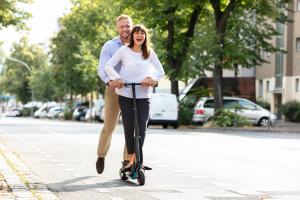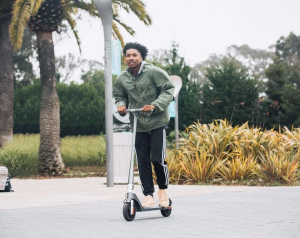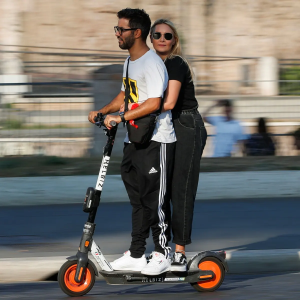Whether it is feasible to carry passengers on electric scooters depends mainly on local laws, the model and load-bearing capacity of scooters, and safety considerations
Safety Considerations for Carrying Passengers
When it comes to carrying passengers on an electric scooter, safety is the primary concern. Understanding the dynamics of riding with an additional person and the changes this brings to the handling and performance of the scooter is crucial. This section delves into key aspects such as weight limits, balance issues, and the necessary safety gear.
Weight Limits and Balance Issues
Every electric scooter has a specific weight limit, which manufacturers design based on the scooter’s frame strength, motor power, and braking efficiency. Exceeding this limit can lead to reduced performance, increased wear and tear, and potential safety hazards. For instance, a typical electric scooter might have a weight limit of around 220 to 260 pounds (100 to 118 kilograms). When choosing a scooter for two people, it’s essential to consider the combined weight and opt for a model that can comfortably handle this load.
Balance is another critical factor. Adding a second person changes the scooter’s center of gravity, which can affect maneuverability and stability. Riders should practice in safe, low-traffic areas to get accustomed to the different weight distribution. Ideally, both riders should remain as still as possible, with the passenger mimicking the movements of the driver to maintain balance.
Essential Safety Gear and Precautions
Safety gear is non-negotiable when riding with a passenger. Helmets are a must, and they should meet safety standards such as those set by the U.S. Consumer Product Safety Commission or similar regulatory bodies. Additional gear like knee and elbow pads, gloves, and appropriate footwear enhances safety, especially for longer rides or higher speeds.
Precautions also include understanding and adhering to local traffic laws. Some regions may have specific regulations regarding electric scooters, which could include restrictions on carrying passengers. Before setting out, ensure that both riders are aware of signals and basic safety rules, like avoiding sudden stops or sharp turns.
It’s also wise to conduct regular maintenance checks when frequently carrying a passenger. This includes verifying the tire pressure, brake function, and battery performance. For electric scooters, battery life is a key parameter. A standard scooter might offer a range of 15 to 20 miles (24 to 32 kilometers) on a single charge, but this can significantly decrease with additional weight and should be factored into trip planning.
Types of Electric Scooters Suitable for Passengers
When selecting an electric scooter for carrying passengers, it’s vital to consider models that offer enhanced stability, power, and specific features designed for two riders. Not all electric scooters can safely accommodate more than one person, so focusing on those built for this purpose is key.
Models with Enhanced Stability and Power
Electric scooters suitable for passengers usually feature more robust motors and larger batteries. A motor with a power output of at least 500 to 750 watts is preferable for maintaining adequate speed and torque when carrying an extra person. The Segway Ninebot MAX, for instance, is known for its 350W motor, which might be on the lower end for two riders, especially on inclines.
Battery capacity also plays a significant role. A scooter designed for two should have a battery large enough to ensure a range that isn’t drastically reduced by the extra weight. Look for a battery with a capacity of at least 500Wh (Watt-hours), which typically translates to a range of 20 to 40 miles (32 to 64 kilometers) under normal conditions. However, carrying a passenger might reduce this range by 10-30%.
Stability is another crucial factor. Scooters with wider decks provide more foot space, contributing to better balance. Larger wheels (10 inches or more in diameter) and a suspension system are also desirable features, as they offer improved stability and a smoother ride over various terrains.
Features to Look For in a Two-Person Scooter
When assessing a scooter for two, several key features stand out:
- Reinforced Frame: The frame should be sturdy enough to handle the extra weight without compromising the integrity of the scooter. Materials like reinforced aluminum or steel are common in higher weight capacity scooters.
- Adjustable Speed Settings: This allows for better control, especially when carrying a passenger. Slower speeds might be necessary for maintaining balance and safety in crowded areas.
- Dual Braking System: A scooter with both an electric and a mechanical brake provides extra safety, especially crucial when stopping distance increases with added weight.
- Ample Lighting: Good lighting is essential for visibility during evening or night rides. LED headlights and taillights are standard features that enhance safety.
- Comfortable Seat: Some models come with an optional seat attachment. This can be a valuable addition for passenger comfort during longer rides.
- Display and Controls: An easy-to-read display showing speed, battery life, and other vital metrics is important. Controls should be easily accessible and intuitive to use.
Riding Techniques with a Passenger
Mastering the art of riding an electric scooter with a passenger requires understanding and practicing specific techniques. These techniques focus on maintaining balance, ensuring safety, and coordinating effectively with the passenger. It’s not just about the rider’s skill; the passenger plays a crucial role in maintaining stability and safety.
Balancing and Maneuvering Skills
Balancing an electric scooter with an extra person requires adjustments in the way you ride. Here are key points to focus on:
- Starting and Stopping: Begin with a stable, balanced stance. The rider should slightly lean forward when starting to counterbalance the extra weight at the back. When stopping, both riders should remain as still as possible to avoid destabilizing the scooter.
- Turning and Cornering: Slow down before making turns or cornering. The rider should gently lean into the turn, and the passenger should follow the rider’s lead. Sharp or sudden turns can easily lead to loss of balance.
- Speed Management: Maintain a steady, moderate speed. High speeds can make the scooter more difficult to control, especially with the added weight and altered center of gravity.
- Weight Distribution: The passenger should sit or stand as close as possible to the rider to keep the weight centered. Sudden movements or shifts in weight from the passenger can make the scooter unstable.
Communication and Coordination While Riding
Effective communication and coordination between the rider and passenger are essential for a safe and enjoyable ride.
- Pre-Ride Briefing: Before starting, discuss signals for turning, stopping, and other maneuvers. Establish a method of communication, whether verbal cues or hand signals.
- Synchronized Movements: Both the rider and passenger should work in harmony, especially when leaning for turns or adjusting positions. Synchronized movements help maintain balance and prevent unexpected shifts in weight.
- Awareness of Surroundings: Both parties need to stay aware of their surroundings. The passenger can assist by keeping an eye on rear-approaching vehicles or obstacles, if feasible.
- Regular Practice: Like any skill, riding with a passenger improves with practice. Start with short trips in a safe, controlled environment before venturing into traffic or longer routes.
Insurance and Liability Aspects
Navigating the realms of insurance and liability is crucial for electric scooter riders, especially when carrying passengers. Understanding the nuances of insurance coverage and the potential liabilities in case of accidents can help riders make informed decisions and prepare for unforeseen circumstances.
Understanding Insurance Coverage
Electric scooter insurance coverage varies widely depending on the provider and the region. Typically, it covers aspects like damage to the scooter, theft, and personal injury. However, when it involves carrying a passenger, the coverage might differ.
Personal Injury Protection: This is vital for covering medical expenses in case of an accident. It’s important to check if the policy extends to passengers or if additional coverage is necessary.
Liability Insurance: This covers damage or injury to third parties. In the context of electric scooters, this is particularly important as accidents can involve pedestrians or other vehicles.
Comprehensive and Collision Coverage: While not always mandatory, these cover damages to the scooter itself, whether from accidents, vandalism, or theft.
Each insurance policy has its specifics regarding deductibles, limits, and exclusions. It’s essential to thoroughly review these details, ensuring that the coverage aligns with the risks involved in carrying a passenger.
Liability in Case of Accidents
Liability in the event of an accident involving an electric scooter can be complex. If the rider is at fault, they could be held responsible for damages or injuries incurred by the passenger or third parties. This underscores the importance of having adequate liability insurance.
Determining Fault: In the event of an accident, determining who is at fault is critical. This could depend on factors like adherence to traffic laws, the scooter’s condition, and the rider’s behavior.
Legal Implications: If the rider’s negligence leads to an accident, they could face legal action. This could include claims for medical expenses, lost wages, or other damages.
Passenger’s Role: The passenger also has a responsibility to follow the rider’s instructions and not engage in behavior that could cause an accident, like sudden movements or distractions.


